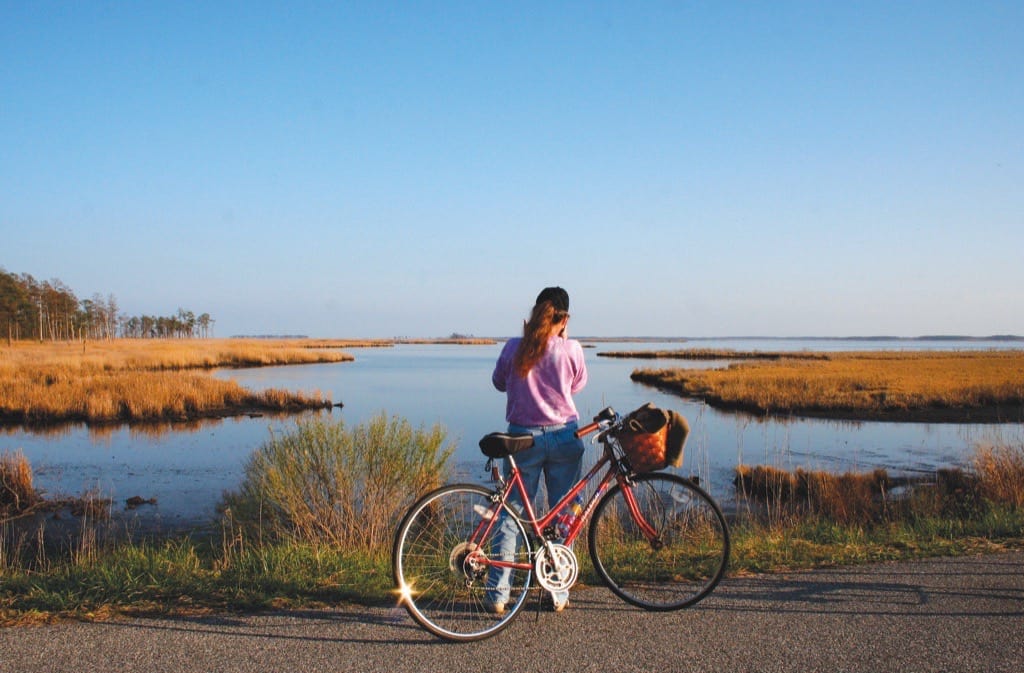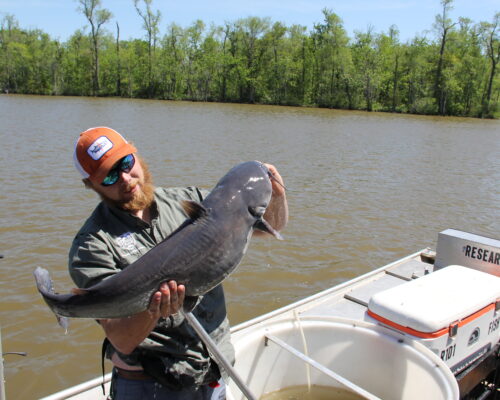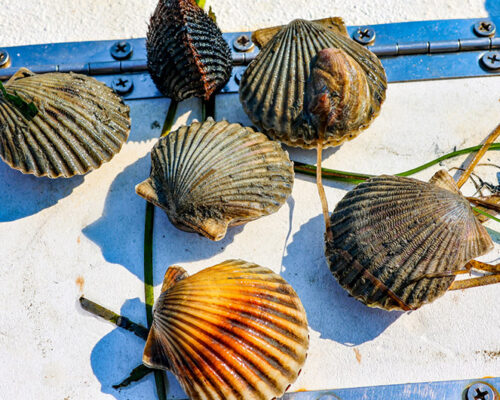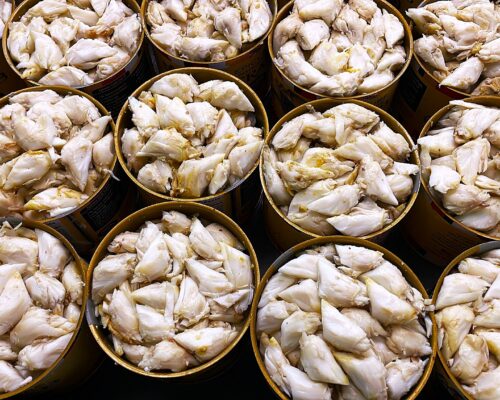Human-powered Bay trips
Hunting, fishing, and boating make of the bulk of my time spent outdoors, and by extension this column. Hiking and biking in the Bay watershed may not fit the strictest definition of “Wild Chesapeake,” but both are worthy pursuits that I enjoy. With that in mind, dear reader, here’s my take on a few of the numerous places to bike and hike in Bay Country.
Eastern Shore Gems
Flat roads and pristine areas rich with wildlife make the Delmarva Peninsula well-suited for bike rides and day hikes. Among the most popular with cyclists of every skill level is the Blackwater National Wildlife Refuge, less than 20 minutes from Cambridge and an easy day trip from most cities in the Bay region.
Back in the day, I biked the refuge’s roads while taking part in the Eagleman Triathlon. Trying to knock out 70 miles in the saddle and not keel over from exhaustion left little time to appreciate the more than 28,000 acres of marsh and forest with their abundant wildlife. As part of our national network of public lands, Blackwater’s visitors center provides maps detailing local roads and the bike trails.
Blackwater offers a four-mile and a seven-mile loop trail down Wildlife Drive ($1 per bike). Twenty- and twenty-seven mile routes are also an option on county-maintained roads. The visitors center has plenty of parking, which makes it an ideal launching point for biking the loops. After the ride, check out the Harriet Tubman Underground Railroad Visitor Center, located just down the road in Church Creek. I’ve been twice. It’s amazing.
Usually, when I’m traveling south along Route 13 towards Virginia, I’m headed to fish for spotted sea trout, red drum, or cobia, or to hunt ducks. In-between outings, I may pedal the Southern Tip Bike & Hike Trail, located in southern Northampton County. The trail runs just under five miles from the Eastern Shore of Virginia National Wildlife Refuge, past Kiptopeke State Park on a paved, 10-foot-wide, ADA-compliant trail. It is flat and weaves through woods and fields at an easy grade. The lower ESVA also has cool water trails—virginiawatertrails.org/easternshore.
Chesapeake Bay Magazine contributor Clara Vaughn, a native of Virginia’s Eastern Shore, helped create the Southern Tip Hike & Bike Trail as a regional planner at the Accomack-Northampton Planning District Commission.
“My favorites hikes are our Nature Area Preserves—Brownsville, Cape Charles and Savage Neck Dunes. All have walks of varying distances that take you through some great local landscapes,” she said. “Savage Neck is especially rewarding as the trail is relatively short and takes you through several types of maritime ecosystems before opening to a near-private beach on the Chesapeake Bay.” This is a lovely area to explore, especially in the fall when most of the bugs are gone.
Glorious Shenandoah Valley
The headwaters of both the James and Potomac rivers begin in the Shenandoah Valley. Combined, these rivers account for about 30 percent of the freshwater entering Chesapeake Bay, so what happens upstream impacts on not only local water quality but Bay waters as well.
In a previous career I helped survey an unnamed feeder tributary to Christians Creek, which drains into the Shenandoah River. Using seine nets, we gently snared freshwater crayfish, a salamander, juvenile bream, and a northern sand shiner. We spotted a Baltimore oriole and a couple of different swallows, including the tree swallow, resplendent with its beautifully iridescent head.
Flora and fauna abound in the Shenandoah Valley, making it an awesome place to hike and bike. The forest of the adjacent National Park explodes with wild plants under an impressive canopy, and the region’s myriad streams run cold and clear. The fishing is good, too.
There are over 500 miles of hiking trails in the Shenandoah National Park, ranging from easy to moderately strenuous to very strenuous. The North District, from Front Royal to U.S. Rt. 21, is very popular with day hikers due to its proximity to Washington. Old Rag Mountain, located within the Central District of the park (U.S. Rt. 211 to U.S. Rt. 33), is one of the most popular and challenging hikes region. It’s a nine-mile scramble, and the park recommends allowing seven to eight hours and two quarts of water to complete the trip.
Old Rag is usually accessed from the Park’s boundary off Route 600. The Shenandoah National Park-managed parking lot accommodates about 265 vehicles, and parking is free, but there is a 7-day entrance fee for the park ranging from $15 for a walk-in or bicycling individual, $25 for a motorcycle, and $30 for a vehicle and passengers.
Along the Rapidan River, a tributary of the Rappahannock, sits Rapidan Camp, a historical site once called the “summer white house” of President Herbert Hoover. Trails from the Rapidan Camp area include Milam Gap, the Appalachian Trail to Tanners Ridge Road Hike, and the Mill Prong to Laurel Prong Loop Hike. Autumn is an ideal time to visit the natural splendor of the Shenandoah Valley. Weekdays are less crowded, of course.
Biking Fun in the Patapsco River Valley
That great modern thinker Ricky Bobby once opined, “If you ain’t first, you’re last.” It was in Patapsco Valley State Park, a 14,000-acre public recreation area just a short drive from D.C., Annapolis, and Baltimore where I tried to put that sage advice into practice.
On one of the park’s mountain bike trails, a friend and I engaged in an impromptu race. First, we pedaled uphill, testing each other out. On the drop, things escalated quickly, going from collegial to cutthroat. About two-thirds of the way down I endured my most epic fall on a mountain bike. I hit a root going way too fast and sailed tail over teakettle, all in a vain attempt to be first. And thus, I was last.
Patapsco Valley State Park attracts hardcore and even professional grade mountain bikers—including the Tour de Patapsco, a 53.7-mile ride for pros and semi-pros—but it is also well-suited to amateur bikers. Be you looking for a challenge or leisurely pedal, the park has trails to fit either skill level. Some feature steep climbs and fast descents (see above), technically challenging rock gardens, as well as hike-a-bike portage across the river. The Avalon/Orange Grove and McKeldin trails feature single tracks that challenge advanced mountain bikers.
Many trails are well suited to the occasional cyclist, however. The park stretches for 32 miles on each side of the Patapsco River, and features a myriad of hiking and biking trails with pavilions and restrooms, making it a great day-trip destination for families or those just looking to chill with nature.
Other great parks on my list include Tuckahoe State Park at Queen Anne, Maryland; First Landing State Park, Virginia Beach; and Elk Neck State Park, Northeast, Maryland.




